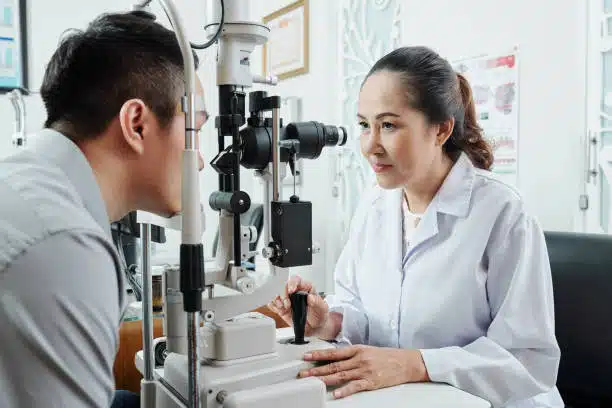The Value of Regular Examinations with an Eye Doctor Optometrist
The Value of Regular Examinations with an Eye Doctor Optometrist
Blog Article
Exploring the most recent Technological Developments in Optometry and What They Mean for Eye Doctors
From the precision of Optical Comprehensibility Tomography to the nuanced understandings provided by AI-driven diagnostic devices, these technologies are establishing brand-new standards in person evaluation and treatment. As these advancements permeate the technique, optometrists are encountered with the obstacle of embracing these devices to enhance person end results.
Innovations in Diagnostic Devices
Progressing the area of optometry, innovations in analysis devices have actually transformed the means eye treatment specialists evaluate and identify ocular conditions and visual disabilities. The past decade has actually observed considerable technical improvements, allowing more exact and detailed assessments. Optical Comprehensibility Tomography (OCT), for instance, gives high-resolution cross-sectional pictures of the retina, permitting the very early detection of diseases such as glaucoma and age-related macular deterioration. This non-invasive imaging technique has ended up being essential in contemporary optometric practice.
Another key development is the introduction of innovative corneal topography systems, which map the surface area curvature of the cornea with precision. These tools are specifically useful for fitting contact lenses and diagnosing corneal problems. In addition, digital retinal imaging has changed standard ophthalmoscopy, supplying comprehensive, scenic views of the retina that assist in detailed visual evaluations.
The development of wavefront aberrometry has likewise been vital, enabling the analysis of refractive mistakes with unequaled precision (Opticore Optometry). This modern technology assists in tailoring corrective lenses and improving surgical results for refractive surgeries. Jointly, these diagnostic innovations empower eye doctors to provide exceptional patient treatment, making sure very early intervention and tailored treatment methods, eventually enhancing visual health and wellness results
AI in Patient Management
Building on the structure of advanced analysis tools, the unification of expert system (AI) in person administration represents a transformative jump for optometry. AI systems are significantly utilized to boost performance, accuracy, and customization in patient treatment. By assessing vast quantities of information, AI can recognize patterns and forecast potential ocular conditions, allowing eye doctors to tailor interventions better. This ability is essential in managing persistent eye illness such as glaucoma and diabetic person retinopathy, where early discovery and constant surveillance are vital.
Additionally, AI-driven systems promote structured patient communications and administrative procedures. Automated scheduling, online assessments, and customized follow-up strategies not just enhance individual contentment yet likewise optimize time administration for experts. These systems can triage clients based on the necessity of their problems, ensuring that those in crucial requirement obtain timely interest.
Additionally, AI improves decision-making by giving optometrists with evidence-based referrals and therapy pathways. By incorporating information from digital health and wellness records, AI tools provide insights that notify professional choices, lowering the danger of mistakes and improving person results. As AI remains to advance, its function in patient management will likely increase, improving the landscape of optometric treatment.
Breakthroughs in Retinal Imaging
In the world of optometry, retinal imaging has actually observed amazing technical developments that are boosting analysis capacities and patient treatment. Technologies such as Optical Coherence Tomography (OCT) and fundus digital photography have revolutionized just how optometrists evaluate the retina and imagine.
Improved imaging techniques like OCT angiography are further refining analysis accuracy. This non-invasive method maps blood circulation in the retina, providing critical insights into vascular health without the need for dye shots. Furthermore, flexible optics technology is being integrated into retinal imaging systems to correct eye aberrations, providing extraordinary picture quality. Such advancements help with the recognition of min retinal modifications that could symbolize disease development.
Additionally, innovations in synthetic knowledge are boosting retinal imaging by making it possible for automatic analysis of big datasets. These systems aid optometrists in recognizing patterns indicative of pathology, therefore boosting analysis precision and efficiency. Jointly, these developments are changing retinal imaging into a keystone of modern eye care, imp source boosting outcomes and broadening healing opportunities.
Teleoptometry's Growing Function
Teleoptometry is significantly becoming an essential element of eye care, driven by advancements in electronic interaction and diagnostic devices. This is specifically helpful in underserved and country locations where accessibility to specialized eye treatment is commonly restricted.
The assimilation of fabricated knowledge (AI) additional improves teleoptometry, allowing the analysis of aesthetic information and assisting in the discovery of eye problems such as glaucoma and diabetic retinopathy. AI-powered formulas can quickly translate complex imaging information, providing eye doctors with beneficial understandings that strengthen clinical decision-making.
Moreover, teleoptometry supports connection of treatment via seamless assimilation with digital wellness documents (EHRs), permitting eye doctors to maintain detailed person histories. This guarantees that individuals receive constant and tailored care also when seeking advice from various professionals.
Regardless of these advantages, challenges continue to be, consisting of making sure information protection and taking care of person expectations. However, teleoptometry stands for a significant stride towards even more obtainable, efficient, and patient-centered eye treatment. As modern technology progresses, its function is positioned to expand additionally.

Future Fads in Eye Care
A myriad of ingenious trends is readied to reshape the future of eye treatment, driven by technological developments and the evolving demands of patients. One considerable fad is the assimilation of synthetic intelligence (AI) in diagnostics, which assures to boost the precision and efficiency of eye evaluations. AI algorithms can examine substantial amounts of information from retinal images, potentially discovering problems like diabetic retinopathy and glaucoma earlier than traditional methods.
Furthermore, individualized medicine is acquiring traction in optometry, with hereditary testing notifying personalized therapy strategies. This strategy aims to optimize client end results Get More Info by tailoring treatments to specific genetic profiles. Wearable modern technology, such as clever call lenses, is additionally imminent, providing real-time tracking of intraocular pressure or glucose degrees, therefore giving continuous understandings right into systemic and ocular health.
The fostering of augmented fact (AR) and online fact (VIRTUAL REALITY) in training and client education is another emerging trend. These technologies provide immersive experiences that can enhance understanding and abilities both for eye doctors and individuals. As these fads evolve, optometrists need to remain abreast of technological innovations to provide innovative care, making certain enhanced client results and fulfillment in the vibrant landscape of eye treatment.
Final Thought

Jointly, these diagnostic improvements encourage optometrists to provide superior person treatment, making certain early intervention and tailored therapy methods, ultimately enhancing visual wellness end results.

As these technologies continue to progress, eye doctors must adapt and include them into practice, eventually enhancing process effectiveness and elevating the requirement of eye treatment delivered to individuals.
Report this page